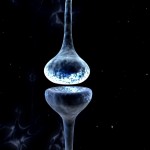Deer in the Headlights: Attention and the Quantum Zeno Effect
“The world is a dynamic mess of jiggling things if you look at it right. And if you magnify it, you can hardly see anything anymore, because everything is jiggling and they’re all in patterns, and they’re all lots of little balls. It’s lucky that we have such a large scale view of everything, that we can see them as things, without having to worry about all these little atoms all the time.” — Richard Feynman
Lately lots of anti-materialist writers are describing the brain as an interface between consciousness and the physical organism, a way of translating nonlocal mind into material intention. Quantum physics is typically invoked to explain how this might happen, yet it often involves a lot of vague hand-waving. I admit to being guilty of said hand-waving. It sounds nice and impressive to talk about “collapsing wave functions” and whatnot, but there’s no way for non-physicists to really evaluate such claims, and honestly, resolute skeptics and materialists are right to distrust us when we make these kinds of speculations.
The privileging of consciousness in most of our jerry-rigged and often desperate-sounding New Age accounts of intention affecting reality sound a lot like wish-fulfillment: We want it to be the case, but we can’t actually say how it is the case, with any kind of real conviction.
Although the idea that consciousness emerges from material processes can never be more than an idea, hence within consciousness—as any number of writers, from Rupert Sheldrake to Deepak Chopra to Bernardo Kastrup have very nicely pointed out in recent books—the materialist bad guys are on much firmer ground in saying that quantum effects, at least in most mainstream interpretations, hold mainly on a microscopic level. How does collapsing an electron’s wave function through observation translate to changing the New York Times on my doorstep from a possibility to an actuality when I open the door to retrieve it?
Another big Achilles heel in anti-materialist invocations of quantum mechanics is in somehow thinking that the randomness that negates determinist causation on the particle level by itself opens the door to free will on a human scale. Even if it’s not actually a classical, billiard-ball world down there with all those jiggling particles, randomness alone does not provide any account of consciousness as a free agent in our human world.
Thus, as it now stands, the privileging of consciousness in many of our jerry-rigged and often desperate-sounding New Age accounts of intention affecting reality sound a lot like wish-fulfillment: We want it to be the case, but we can’t actually say how it is the case. Frankly, I wouldn’t trust us on these questions, if I were a heardheaded materialist skeptic.
This is where I have been extremely impressed (blown away, really) by the work of Henry P. Stapp, a theoretical physicist who has been working on this problem his whole career, and who has produced a rather dazzling quantum-mechanical account of how the brain may translate conscious intention into macroscopic effects. This isn’t the usual vague hand-waving. Stapp’s book Mindful Universe walks the reader through the history and underpinnings of quantum physics in a thorough but remarkably readable manner, and explains at every step of the way not only why consciousness must factor in to our understanding of the physical universe on a very fundamental level (the Copenhagen-Von Neumann Interpretation) but also how our brains may work as an interface between consciousness and the machine of the body, through precisely the “probing” (i.e., posing of “yes/no” questions) that quantum mechanics models in its most iconic experiments.
 Consciousness basically is an experimenter, Stapp says—a chooser of what questions to ask of nature. On a particle level, nature is free to answer however she chooses (i.e., randomly), yet there is a crucial loophole: a phenomenon known as the Quantum Zeno Effect. This effect may be decisive for the way consciousness influences the actions of the meat machine via the brain. Specifically, persistent rapid probing of reality produces the same “answer” repeatedly from the physical world, effectively “stopping time” in some sense—hence the name of the effect, which refers to Zeno’s paradoxes like an arrow that must first get halfway to its target, but first halfway to that, and so on, and thus never being able to leave the bow at all.
Consciousness basically is an experimenter, Stapp says—a chooser of what questions to ask of nature. On a particle level, nature is free to answer however she chooses (i.e., randomly), yet there is a crucial loophole: a phenomenon known as the Quantum Zeno Effect. This effect may be decisive for the way consciousness influences the actions of the meat machine via the brain. Specifically, persistent rapid probing of reality produces the same “answer” repeatedly from the physical world, effectively “stopping time” in some sense—hence the name of the effect, which refers to Zeno’s paradoxes like an arrow that must first get halfway to its target, but first halfway to that, and so on, and thus never being able to leave the bow at all.
Previous efforts toward a quantum neuroscience, like that of Roger Penrose (Shadows of the Mind), have focused on narrow cellular structures where quantum indeterminacy can come into play. Penrose focused on microtubules that extend through cells, but Stapp focuses on very narrow ion channels in the walls of synapses as sites where, through probing actions that amount to querying the behavior of particles, consciousness takes control of the brain and body. We’re obviously not conscious, in the sense of “aware,” of this querying, as it happens many times a second, at trillions of locations throughout the nervous system; the idea is that cortical activity is entangled and coherent, a unified orchestration of these micro Zeno effects. It reminds me of Feynman’s sense of relief that we do not need to actively micromanage our affairs at the particle level, which would be just too daunting a task. The brain, conveniently, is the organ scaling up those particle-level actions via quantum coherence, enabling them to have macro-level effects. If Stapp is right, we ourselves are macro-scale quantum phenomena.
From Quantum Hand-Waving to Quantum Finger Lifting
Stapp uses the Quantum Zeno Effect to account for the most baffling (and on the surface, most seemingly materialism-supporting) finding in neuroscience, Benjamin Libet’s 1983 discovery of a roughly half-second delay between the initiation of a consciously formulated action—a measurable neurological “readiness potential”—and its actual appearance in conscious awareness. Libet’s and subsequent experiments on this phenomenon (for instance those of psychologist Daniel Wegner) seemingly were the nail in the coffin of “free will” as we ordinarily understand it, since they seemed to show that an intention to move the body follows rather than precedes the observed action. In his contribution to the recent collection, Beyond Physicalism, Stapp addresses Libet’s finding, arguing that it reflects instead an illusion produced by observation-related collapse a la Heisenberg.
If Stapp is right, the bodymind is PhilDickian to its core: The calcium ions triggering neurotransmitters to cross the synaptic cleft are little Schrodinger’s cats.
To perform an action, the neural command architecture should already be primed in advance and ready, like a spring; in an uncertain universe, a range of possible actions should all be readied, and thus a large range of neural actions should be primed in the invisible no-space of quantum superposition (what I have called the Quantum Not Yet). The choice to make a particular action amounts on the neuronal level to a choice to observe a quantum state (in other words, consciousness as experimenter again), which collapses that fan of potential action templates to a single actual readiness potential; the unactualized possibilities disappear. In a very real sense, our every decision to move a muscle is acting “retrocausally” by collapsing the fuzzy smear of possible readiness potentials to a definite, determined one, producing an apparently paradoxical effect of an effect (the measured readiness potential) preceding its cause (the conscious decision to make this muscle motion rather than that one or none at all).
 If Stapp is right, the bodymind is PhilDickian to its core: The calcium ions moving through narrow vesicles and triggering neurotransmitters to cross the synaptic cleft are little Schrodinger’s cats, and the implication is that in our very early development our consciousness learned to control this process through a form of (small-scale) persistence, repeatedly posing the same “yes/no” questions and discovering that this persistent probing had the power to move the body in relatively predictable ways.
If Stapp is right, the bodymind is PhilDickian to its core: The calcium ions moving through narrow vesicles and triggering neurotransmitters to cross the synaptic cleft are little Schrodinger’s cats, and the implication is that in our very early development our consciousness learned to control this process through a form of (small-scale) persistence, repeatedly posing the same “yes/no” questions and discovering that this persistent probing had the power to move the body in relatively predictable ways.
Watched Pots
The Quantum Zeno Effect could be described as a prophylactic against information loss (entropy gain), as a result of focused, persistent attention, or the seeking of information. Sometimes called the “watched pot effect,” this can even be thought of as the local stopping or slowing of time, could it not? Reality, in other words, is like a deer that freezes in attention’s headlights. One mind-blowing implication of this—although I don’t think Stapp articulates it this way—is that it seems to offer further evidence there is no single temporal stream but that everything, every particle, has its own temporal flow, depending partly on the level of attention it receives. Those flows locally may tend to average out and give the illusion of coherence, but focused attention on some part of a system may actually slow its unfolding, perturbing the whole in a certain direction.
Could narrow focused engagement actually alter the local flow of time around the object of attention? Is the shaping of time around our activity a real effect and not just a subjective illusion?
If the Quantum Zeno Effect is the basic “hack” by which conscious intention fashions the world to its desires and in its image, it could explain numerous effects experienced by athletes and creative writers and artists who experience “flow” states—expanded subjective time as a function of how narrowly versus diffusely the attention is focused on a problem or task. Could narrow focused engagement actually alter the local flow of time around the object of attention? Is the shaping of time around our activity a real effect and not just a subjective illusion?
It’s easy to extrapolate from this small-scale, nuts-and-bolts picture of quantum interfacing with our meat-mecha-body to advanced and effortful kinds of coherent “probing” in the form of meditation and other types of focused mental discipline. These may potentially capitalize on the Quantum Zeno Effect for more remarkable feats in which we influence not only the body but also the external material world, for instance in psi phenomena. Stapp’s theory has implications, in other words, for how attention might manifest intention.
That would be just one more reason why attention—the focusing and directing of consciousness—is the most precious resource there is, as well as our fundamental superpower birthright. There are countless ways our attention is captured and redirected by media, technology, and attention-needy persons and institutions; and there are many ways culture itself acts as a psi-delimiting system, precisely by scrambling and weakening our powers of attention. So, if you aren’t already working your attentional muscle in some kind of daily meditation practice, to defeat these corrosive forces on your psi, WTF are you waiting for?






This is a brilliant post, and I needed to read this today, so thank you.
I find the materialist notion that we have no free will so absurd as to deserve no attention or debate, and I love this idea that attention shapes reality.
Obviously, it’s time to get to work on my attentional muscles. 🙂